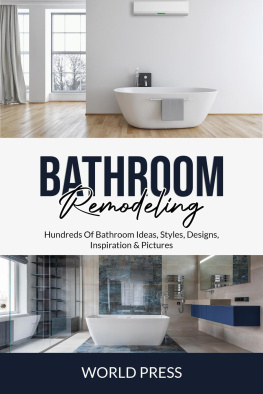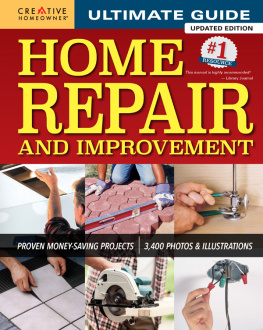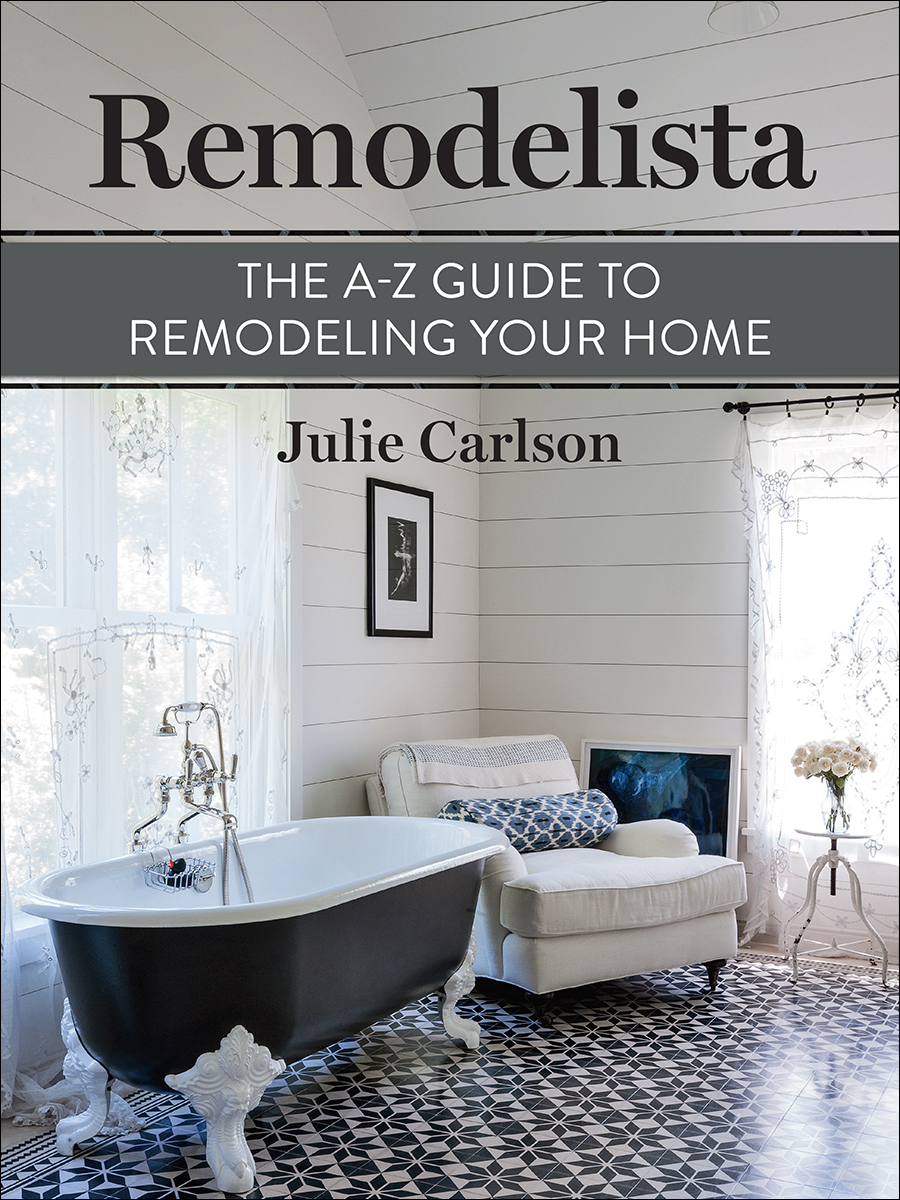Remodelista:
The A-Z Guide to Remodeling Your Home
Julie Carlson
With the editors of Remodelista
Written and edited by Margot Guralnick
Photographs by Matthew Williams
Contents
Remodeling Reality
Youve heard the horror stories: projects that drag on for months, even years, past the projected finish dates. Budget overruns that drain bank accounts. Couples that split up the minute they cross the threshold of their newly remodeled abodes. Trust us, it doesnt have to be this way.
Among us weve been through more than a dozen remodels. Miraculously, weve survived the financial strain, were friends with our architects, and we sing the praises of our contractors. If that sounds smug, well admit that luck had a lot to do with it. But the results have been so life-changing that were inspired to share our strategies with you in hopes of making your own experience less daunting. Remodeling is messy and arduous. But it can also be transformative, an aesthetic journey youll never regret.
By Meredith Swinehart
01
Before You Begin
Size up your project by asking yourself these crucial questions. The more informed you are about what youre getting into, the smoother and speedier the process will be.
Is It Worth It?
Most successful remodeling stories begin with a house or an apartment that shows underlying promise: what decorators like to call good bones. Look beyond misguided paint choices and ugly carpeting for well-proportioned rooms that flow well from one to the nextor, at least, present signs of possibility, such as an open-plan living/dining space in an otherwise forgettable ranch house. If you are considering buying a place with the intent to remodel, do not pass go without getting the advice of an architect and a contractor. Many offer this service gratis, hoping that a job will follow. They will provide insights into whats possible, how much it will cost, and whether the project is worthwhile. If your goal is a complete overhaul, keep in mind that its cheaper and easier in the long run to shoulder one big remodel than to break the work into stages. And before you make any moves, consider leaving things as is for a few months. Its enormously helpful to test-drive a house before you fix it.
Where Will You Live During the Project?
Remodeling is noisy, chaotic, and, above all, dusty. If youre doing a minor update (a small bathroom, for instance), its fine to stay put. But if youre doing a major overhaul, consider renting a place nearby or offering your services as a house sitter.
How Do You Want to Live?
Think of remodeling as an opportunity to define your aesthetic. Whether or not you enlist the help of an interior designer, take time to size up your likes and dislikes and establish priorities. Most important, trust your instincts. As designer Ellen Hamilton says, Its a pitfall to think that the design professional knows better than the homeowner in matters of taste. To get the best results, its important for the person whos going to be living in the space to know his or her own mind.
How to begin?
Gather images of rooms that speak to you. Remodelista is an ideal resource; so are other websites (see our sites Design Newsstand), books, magazines, and the world at large. Build your design files online with sites like Pinterest, Tumblr, or Evernote, which make it easy to add targeted captions, or with hard copies pinned to a mood board or stashed in a folder. Look for themes in your selections, and winnow out anything that on a second or third glance doesnt hold up.
Steep yourself in your stuff. What is and isnt working for you now? What would you hate to see go? Pay attention to your patterns and habits. You might dislike the way your current kitchen cabinets look but love the ease with which they open.
Make a list of your priorities and goals, and refer to it often. Where is it important to spend a little extra to get what youre after? And where can you save? Aim to consolidate the former and expand the latter. For example, splurge on customized built-in storage and save by buying furniture on sale and at Ikea. Or use marble in the master bath but subway tile in all the others.
Think long-term. Consider how your needs will change over time, and keep your options open. Todays playroom could become tomorrows home office. The nursery will one day morph into a teenagers room. And the extra bathroom just may be the laundry room of your dreams.
Pro Tip
Dream Big
Begin by coming up with a plan that gives you everything you want. True, you may have to scale back on scope and first-choice materials, but the exercise allows you to establish the look and feel that youre after. And it gives you a good sense of what things cost.
Todd Nickey , designer, Nickey Kehoe, Los Angeles
02
A Realistic Budget
Controlling expenses is the most daunting part of any remodel; when youre in the thick of it, it can feel as though youre shoveling money into your house. Heres how to spare yourself and your bank account.
What Will It Cost?
Gathering information up front, before a Dumpster is on the horizon, is your best route forward and can help keep plans in perspective.
Talk to an architect or a contractor. Get an idea early on of what your project may cost. (Unless you intend to hire that architect or contractor, pay for the consultation.)
Consider how long you plan to stay in your house. Will your improvements pay for themselves over the long run? (A contractor can help you answer this.)
Get some friendly advice. If a friend has tackled a similar project, ask her about her total expenditureand then add 50 percent (as a form of self-preservation, people always forget at least half the costs).
Start researching improvements. Spend time looking at the many levels of available finishes, cabinets, plumbing fixtures, lighting, and appliances, so youll be better informed about quality versus cost.
Set aside a slush fund. There are almost always going to be unpleasant surprises when remodeling, and the bigger the project, the more expensive the surprises will be. We suggest banking at least 10 percent of your budget as a contingency in case things go wrong. This fund should not be used to indulge your sudden requirement for a built-in dressing room; its there to cover design and technical overruns.
Pro Tip
Beware Cost-Per-Square-Foot Calculations
These calculations are almost worthless, because there is no standard for whats included in that number. Is architecture? How about building permits? Landscaping? Contractors fees? The other pitfall is that you have no idea if youre comparing apples with apples. If someone builds a house on a hillside, it will cost more than a house on a flat lot. A kitchen might cost $1,000 per square foot and a kids bedroom $100 per square foot. Consequently, using a cost-per-square-foot number to determine your budget is only valid in a very broad sense.
Rich Tincher , contractor, Tincher Construction, Redwood City, California
03
Where to Spend, Where to Save
All of us at Remodelista subscribe to a high/low approach to design: We mix favorite pricey things with accessible, affordable ones. And we see beauty in any well-designed object, whether its from a rarefied boutique or the corner hardware store.













